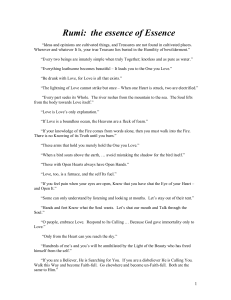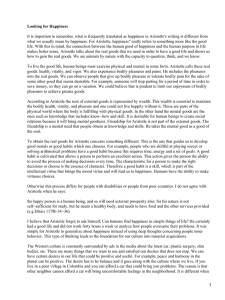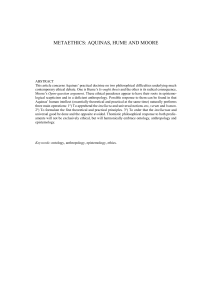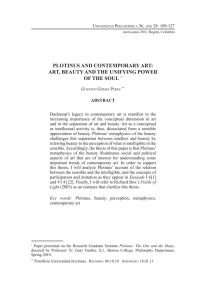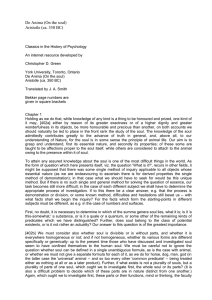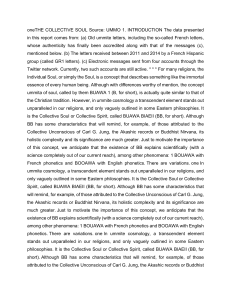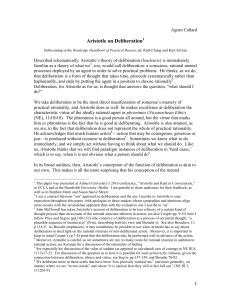On the origin and foundation of the concept “The Person
Anuncio
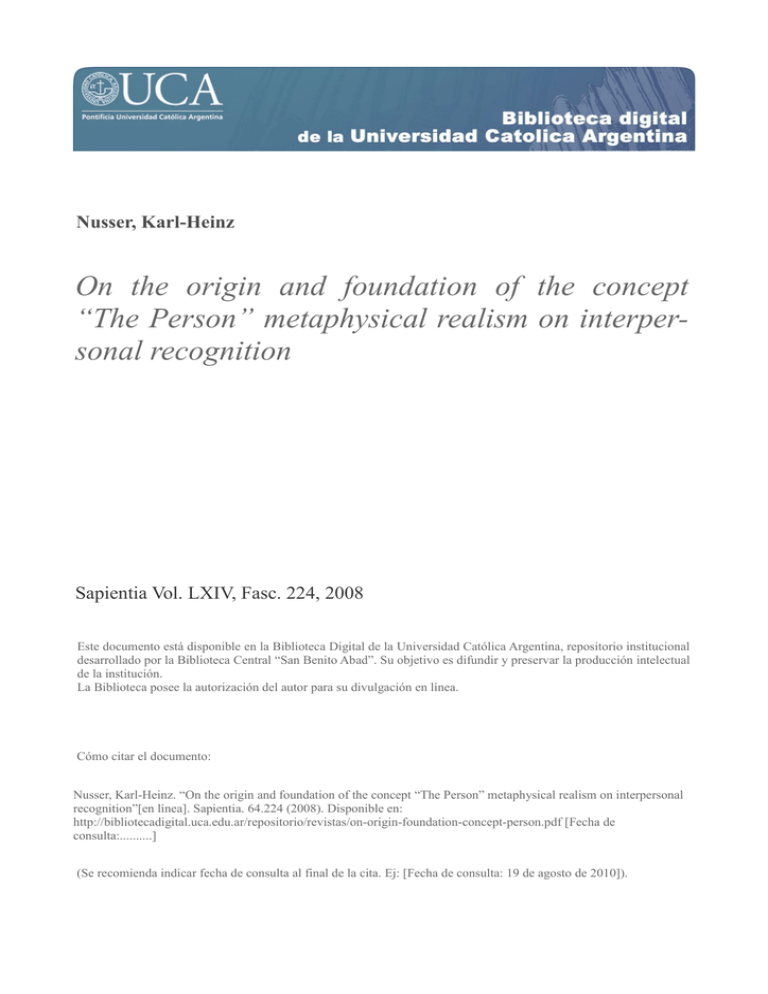
Nusser, Karl-Heinz On the origin and foundation of the concept “The Person” metaphysical realism on interpersonal recognition Sapientia Vol. LXIV, Fasc. 224, 2008 Este documento está disponible en la Biblioteca Digital de la Universidad Católica Argentina, repositorio institucional desarrollado por la Biblioteca Central “San Benito Abad”. Su objetivo es difundir y preservar la producción intelectual de la institución. La Biblioteca posee la autorización del autor para su divulgación en línea. Cómo citar el documento: Nusser, Karl-Heinz. “On the origin and foundation of the concept “The Person” metaphysical realism on interpersonal recognition”[en línea]. Sapientia. 64.224 (2008). Disponible en: http://bibliotecadigital.uca.edu.ar/repositorio/revistas/on-origin-foundation-concept-person.pdf [Fecha de consulta:..........] (Se recomienda indicar fecha de consulta al final de la cita. Ej: [Fecha de consulta: 19 de agosto de 2010]). KARL-HEINZ NUSSER University of Munich On the Origin and Foundation of the Concept “The Person” Metaphysical Realism on Interpersonal Recognition?1 I. Introduction Our initial understanding of the expression ‘the person’ embraces both intellectual and corporeal elements and includes the capability of a moral agent to make decisions and to act upon them. For ordinary purposes this definition would be sufficient. This definition soon reaches its limits, however, when for some reason it must be precisely determined who and for what reasons someone should be regarded as ‘a person’; this difficulty becomes apparent, for example, when considering the status of an Alzheimer’s patient or a criminal. Many democratic Constitutions, define the rights of all its citizens. But for philosophical theory that is not sufficient, for philosophy requires it be demonstrated that such rights are in accord with human nature. According to Kant, one cannot recognize one’s ‘self ’ as the cause of human actions. As a result of that, one would have no theoretical basis for recognizing anyone as ‘a person’. In order to compensate for this theoretical deficiency, it should be clear that recognizing another person requires a moral decision. In interactional theories, like those of Jürgen Habermas and Ernst Tugendhat, the recognition of persons depends on laws that reflect the consensus of citizens who have already attained their status as ‘persons’. This means that a limited number of human beings would decide who is entitled to enjoy full recognition as ‘a person’.2 Ever since the sixth century when Boethius defined ‘the person’ as ‘the individual substance with a rational nature’3, improvements have been made to his definition although some elements of his definition have also been obscured by time. Thomas Aquinas suggested that the roots of ‘a person’ are to be found in an individual subsisting as a unity of body and soul. 1 My thanks go to David Zemel, Munich, for his assistance and suggestions regarding GermanEnglish equivalences and formulations. 2 JÜRGEN HABERMAS, Die Zukunft der menschlichen Natur. Auf dem Weg zu einer liberalen Eugenik, Frankfurt, 2001. ERNST TUGENDHAT, Vorlesungen zur Ethik, Frankfurt, 1993. 3 A. M. S. BOETHIUS, Contra Eutychem et Nestorium: naturae rationabilis individua substantia, in: BOETHIUS, Die theologischen Traktate, translation by Michael Elsässer, Hamburg, 1988, p. 74 and following. 52 KARL-HEINZ NUSSER The joining of the spiritual soul with the physical body constitutes a concrete unity of the species and therefore of the individual. Since the personality does not depend on any particular personal quality but rather on the constitution of its existence, both children and severely handicapped persons are properly considered to be complete persons. While Descartes reduces the unity of ‘the person’ to a duality of a thinking and a corporeal entity, dismissing thereby the basis for understanding ‘a person’, Locke, in contrast to that, substitutes accidental criteria for the unity of ‘the person’. A person’s recollection of himself, together with his observation of himself or another person’s observation of him (should that other person be present to make an observation), completely define and identify ‘the person’. Locke removes himself from the embarrassment, to which Descartes’ Dualism led him, by introducing two definitions of the human essence. He explains the identity of human beings by 1) pointing out their ability to remember their individual actions and experiences, and 2) by their ability to recognize their own body at every time and in every place. In this way, he avoids having to accept the ontological unity of ‘the person’ and the existence of the human soul. As it is easy to see, Locke divides the existence of ‘the person’ into two perspectives, the internal and external experiences. Derek Parfit4 und Peter Singer5 are two modern, influential philosophers whose work is dependent on Locke’s premises. Parfit, in particular, curiously denies the presence of ‘the person’ during sleep. He also asserts that a single human being, during its lifetime, evolves into many succeeding persons. Peter Singer, on the other hand, defines a person as one who can articulate a certain degree of vital interests; in accord with that, an adult pig would be more of a person than a newborn child. The philosophical theory of ‘the Person’ must confront two possible alternatives: either 1) to conceive ‘the person’ as being at the locus of action, which implies ‘the person’s existence; or 2) merely to connect ‘the person’ with the locus of action, which implies the surprising result that not every human being is ‘a person’ at every point in time. Among the current treatises on the subject of ‘the person’, only the book by Berthold Wald, Substantialität und Personalität 6, discusses the question of ‘the person’ from the point of view of metaphysical realism. Although Spaemann’s book on the same subject (Personen7) claims to treat the subject as metaphysical realism, there is some question as to whether it succeeds. Also worthy of mention are Dieter Sturma’s8 and Theo Kobusch’s9 books. DEREK PARFIT, Reasons and Persons, Oxford, 1984. PETER SINGER, Practical Ethics, Cambridge, 1993. 6 BERTHOLD WALD, Substantialität und Personalität. Philosophie der Person in Antike und Mittelalter, Paderborn, 2005. 7 ROBERT SPAEMANN, Personen. Versuche über den Unterschied von “etwas” und “jemand”, Stuttgart, 1996. Here I refer to the English translation: Persons, The Difference between ‘Someone’ and ‘Something’, translation by Oliver O’Donavan, Oxford, 2006. Cited as Persons and the page numbers. 8 DIETER STURMA, Philosophie der Person, Paderborn, 1997. 9 THEO KOBUSCH, Die Entdeckung der Person, Freiburg, 1993. 4 5 ON THE ORIGIN AND FOUNDATION OF THE CONCEPT “THE PERSON” 53 In the following chapters, I will concentrate on Spaemann’s theory, especially his efforts to integrate speech analysis, phenomenology and interactionism in the metaphysical realism. In particular, I will question whether, in his theory of ‘person’, the human soul can retain its central position under the presupposition of the ontological constitution as a transcendental form or if ‘the person’ is comprised only of interpersonal relations. Modern theories that associate the quality of persons with actions typically refute the assertion that ‘the person’ is something that exists within itself, something that derives only from nature. Interactional procedures of law, promoted by people who already have human rights, transfer similar rights to those who don’t yet have them. These procedures replace, as suggested by Jürgen Habermas und Ernst Tugendhat, the assumption of natural endowments in connection with human dignity. If we go back to the conceptions of ‘the person’ as stated by Aristotle and Thomas Aquinas, we can shed light on the natural substance of ‘the person’ and eradicate the one-sidedness of the aforementioned theories. II. The use of language and the classic definition Underlying Thomas’s basic precept is not merely a simple ontology of material things but rather a combination of insights regarding philosophy of mind, ontology and epistemology. That means that the substance, which would be treated in ordinary ontology, should not only be regarded as an individual existence but also one that has the ability to recognize the world and to act freely. By adopting Boethius’s well-known definition of ‘person’, Thomas stays within the great philosophical definition of man as a being equipped with mind and spirit, a definition that we already know from Plato and Aristotle. “Person,” says Thomas, “describes that which is most perfect in all of nature, namely the independent existence of a creature blessed with reason.”10 In the first part of the Summa Theologica, Question 29, Articles 1 und 2 Thomas discusses Boethius’s definition: “naturae rationabilis individua substantia.” This definition states that ‘the person’ is an “individual substance with a rational nature.” In interpreting this, Thomas refers to Aristotle’s two most important meanings of ‘substance’. In Aristotle’s Metaphysics, the term ‘substance’ is used in two senses: “It means the ultimate subject, which is not further predicated upon something else, and it means anything which is a particular being and capable of existing apart. The form and species of each thing is said to be of this nature.”11 In his comments to Aristotle’s foregoing statement, Thomas speaks of the particular substance that exists of itself and is distinct from all other substances, while the form and nature of a universal substance, in contrast to that, subsists only by reason of a particular substance.12 We can illustrate these def10 THOMAS AQUINAS, S. Th., I, q 29, a 3. Cited after the Thomas edition of the Albertus-MagnusAkademie Walberberg, p. 52. Translation by the author. 11 ARISTOTLE, Metaphysics, 1017 b 23-26. Cited from THOMAS AQUINAS, A Commentary on Aristotle’s Metaphysics, Book V, Lesson 10, Nr. 903, edition by John Rowan, Notre Dame, 1993, p. 324. 12 THOMAS AQUINAS, A Commentary on Aristotle’s Metaphysics, Book V, Lesson 10, Nr. 903, translation by John Rowan, Notre Dame, 1993, p. 325. 54 KARL-HEINZ NUSSER initions by imagining Socrates as a particular substance that embodies the essence of a human being, whereas such essence can be incorporated in many bearers. This is an initial logical description of the relationship between the ultimate subject and the species or form, which we will complete later by developing the ontological relationship between form and matter. Taking into consideration Boethius’s definition of the rational being, Thomas indicates that individual rational substances, in contrast to animals, enjoy a more special and complete way of being. “They are in complete command of their acts; they are not forced to act but act by themselves.”13 In reflecting upon spoken language, Spaemann observed that there are two extremely different meanings of the concept ‘person’. We can speak of eight persons who come to dinner or we can speak of ten persons who may enter an elevator. But beyond this purely mathematical means for identifying persons, we can also use the word ‘person’ to express the special dignity which is characteristic of human beings.14 As one can easily see, the meaning of the ‘person’ in everyday language incorporates aspects of both number and essence, which together are in harmony with the classical definition of Boethius. In a further remark about language, Spaemann observed that a ‘person’ is neither a sortal expression nor a quality but rather “the bearer of certain properties.”15 Basing a critical remark on predicate logic, Spaemann explains that a human being does not stand in relation to another human being in the same way that a dog stands in relation to another dog. A man “instantiates the human species in a different way from that in which individual members of other species instantiate theirs.”16 In other words, while a dog is merely an instantiation of its kind, a human being is much more than a further instance of its own kind and has therefore a proper name. Aristotle directs our attention to the fact that by calling an individual person such as Socrates by his proper name we designate both the individual person and the universal nature of the human being. If we could, for example, observe Socrates entering our room, not only would we recognize by empirical observation of his being that it is he, but we would also recognize, at once and without ambiguity, the universal form of the human being. This notion does not apply to instances of material substances. If we draw a number of circles on the board and then point to one particular circle, we would unlikely give that particular circle a name, for that circle, like all the other circles we’ve drawn, is not an individual at all, but merely an imperfect representation of an ideal mathematical form. Every circle shares identical characteristics with all possible circles, a statement we never would make regarding a human being.17 After this brief look into the structure of naming, we will next discuss the structure itself. In connection with this, we will investigate the questions: What THOMAS AQUINAS, S. Th., I, q 29, a 1. Persons, 7 and following. 15 Persons, 14. 16 Persons, 9. 17 ARISTOTLE, Metaphysics, VII, 10, 1034 b 32 - 1035 b 3; cf. THOMAS AQUINAS, Commentary on Aristotle’s Metaphysics, 494. 13 14 ON THE ORIGIN AND FOUNDATION OF THE CONCEPT “THE PERSON” 55 special meaning has the concept of ‘form in itself ’? And what meaning has the form when it constitutes the substance in union with matter? III. ‘The Person’ and the twofold concept of essence Let us first concentrate on the ontological constitution of the rational being and ‘the person’ as given by Thomas Aquinas. He discusses this subject in the first part of the Summa, question 29, article 2 at the refutation of the third objection. We also find the argument in “De ente et essentia,” for example, because it belongs to the theory of ontological constitution. In the objection it was said that the terms ‘hypostasis’, ‘subsistence’ and ‘essence’ have the same meaning. The term ‘essence’, as he defines it, relates only to the general nature of things, so that if ‘hypostasis’ and ‘subsistence’ were to be used in the same way, then ‘identity’ as an attribute of ‘the person’ could not be understood. In his response, Thomas explains that “essence refers neither to form alone nor to matter alone, but to what is composed of both matter and form in general.” He then goes on to say, “Now what is composed of this matter and this form has the character of a hypostasis and a person; for while soul, flesh and bones are part of the meaning of ‘man’, this soul and this flesh and these bones are part of the meaning of this man. Hence ‘hypostasis’ and ‘person’ add to the idea of the essence individual principles, which in things composed of matter and form are not identical with the essence, as we said above when discussing divine simpleness.”18 While one might be tempted to assume that matter alone could be responsible for the concretization of an individual, i.e., individuation, this would be wrong. If we only considered their species, we might think of Socrates and Kallias as being one in the same person. However, we would never think them to be the same person if we also considered their concrete forms, which are different, each having an individual body and biography. In Berthold Wald’s treatise on the term ‘person’, he indicates that “the existence of the species ‘man’ cannot be found in the form of the species but rather in its form as a realization (anima), and therefore exclusively as an individual representative of the species.”19 The most important consequence of form as a realization is that the receptive intellect (intellectus possibilis) is not a separate body but must be conceived as being united with the existence of an individual substance. Understanding is an activity that takes place within the actor, not one that moves him from the outside. In the first part of the Summa Theologiæ, Question 76, Article 1, Thomas indicates that Socrates’ substantial form is his intellect. Without this assumption, Socrates would be but an entity separate from his essence. 18 THOMAS AQUINAS, S. Th. I, 29, a 2, ad 3. Cited after the edition of Ceslaus Velecky, Vol. 6, The Trinity, London/New York, 1965, p. 49 and following. 19 BERTHOLD WALD, Substantialität und Personalität Philosophie der Person in Antike und Mittelalter, Paderborn, 2005, p. 171. 56 KARL-HEINZ NUSSER We can conclude that it is not the general essence of human beings that contains the reality of ‘the person’ but rather the concrete essence. It would be a mistake to think that a human being’s actions are based solely on a form of social relationships without also considering the substance of form as a concrete principle of being. The substantial form is, after all, the decisive factor in determining everything that exists. Thomas defines four forms of material substances of which the highest is the soul: 1. The simplest form is that of material things, for they are without life. 2. There are forms of material things that have life and the capability of taking on nourishment and of reproducing (for example, flora). 3. Then there are forms of material things that have the capability of living, i.e., taking on nourishment, reproducing, perceiving (for example, fauna). 4. The fourth form comprises material things that have the capability of living and have, in addition, the power of reason. Thomas, along with Aristotle, named those forms of material things that have the capability of living - souls. For Thomas, the human soul distinguishes itself from other souls through its intellectual capability.20 The concept of soul can be both individually and universally understood.21 It can mean a soul, in general, but at the same time it can also mean this particular soul. Thus far, we have advanced from the logical analysis of ‘the person’ to the ontological theory of ‘the person’, thereby developing the meaning of the constitutive form of essence, which is the intellectual soul. These ideas may be summarized as follows: 1. The concrete individual, ‘Socrates’, consisting of concrete matter and a concrete form, enters the realm of reality by being both a principle and a cause. It should be clear that form but not matter is the primary reason for the constitution of being. 2. We can give the concrete person a name because we intuitively grasp the humanity in a concrete individual. Similarly, when we speak of this man we are also speaking of this soul and of this person. 3. When we give a specific name to a specific individual, we are concretizing the concept of that individual; otherwise we would only be using a general term to designate inexactly the relationship between some individual matter and some substantial form, as we do whenever we think of ‘a’ person. Next, we will consider Spaemann’s phenomenological determination of ‘the person’. 20 THOMAS AQUINAS, S. Th., I, q 76, a 1. ELEONORE STUMP, “Nichtcartesischer Substanzdualismus und nichtreduktionistischer Materialismus: Thomas Aquinas über die Seele”, in: MATTHIAS JUNG / MICHAEL MOXTER/THOMAS SCHMIDT (Hg.), Religionsphilosophie, Würzburg, 2000, pp. 47-74. 21 THOMAS AQUINAS, Commentary, Nr. 1524 ON THE ORIGIN AND FOUNDATION OF THE CONCEPT “THE PERSON” 57 IV. Spaemann’s phenomenological determination of ‘the person’. Spaemann draws no satisfactory ontological conclusions from the special relationship that exists between ‘suppositum’ and essence, as it applies to concrete human beings. While he touches upon the ontological realm of the relationship between substantial form and matter, he does not go deeply into it. Instead, in a creative reflection, he builds a connection between the certainty of our individual existence that we experience when we speak in the grammatical first person and compares it to the language we use when refer to mere animals.22 He mentions two elements of the definition from Boethius and Thomas for ‘person’ but it is questionable whether he actually succeeds in introducing in his theory the ontological basis for the individuation of the essence and the quality of ‘the person’.23 Instead of developing the ontology of ‘the Person’, he places ‘the Person’ in the center of being. For him “personality is the paradigm for being - not as ‘something in general’ but as transcendence of objectivity, ‘being in itself ’.”24 Although it is not perfectly clear what Spaemann’s statement is meant to express, he may be implying that ‘the person’ comes into being as a result of an activity called ‘transcendence’. If so, one might think of this as an attempt to establish some affinity to Kant’s theory of the primacy of the practical freedom of the human being over the laws of nature, which Kant develops in his Critique of the Practical Reason. As Spaemann’s cryptic formulations defy our understanding, however, we find ourselves forced to return to the problem of the ontological foundation of the ‘person’. As noted earlier, while the assertion that ‘person’ is an essential attribute of the human being does not apply to the explicit logical definition of the concept ‘human being’, it does apply to the individual real substance of human beings. For example, we say that Socrates, who is a particular person, is also a human being. It is therefore obvious that the concrete essence of a human being and the concrete person are one and the same. The essence of a human being and its realization in an individual bearer constitutes ‘the person’, by which is meant that the individual has a concrete essence and, as Thomas says, “[the person] is comprised of this body and this soul.”25 In article 8 of his Quaestiones disputatae de veritatis Thomas discusses the common nature of the soul and what all souls have in common. In this, Spaemann is correct when he declares that it is not possible to identify ‘the person’ within the concept ‘the essence of a human being’. Regarding Spaemann’s concept, however, we have to make a distinction between the insight into the soul that everyone has and “what is characteristic of ‘the person’, himself ” (Thomas). More particularly, in Article 8, Question 10, in the Questions of Truth, Thomas develops the understanding by which the soul of each man “knows itself only with reference to what is characteristic of itself.” And this knowledge, which each person has of its own Persons, pp. 17-49. Persons, pp. 17-49. 24 Persons, p. 67. 25 Thomas Aquinas, Commentary on Aristotle’s Metaphysics, translation and introduced by John P. Rowan, Notre Dame, 1995, Nr. 1490. 22 23 58 KARL-HEINZ NUSSER soul, “being characteristic of himself, is the knowledge of the soul as it is within this individual. It is through this knowledge then, that one knows of the existence of one’s soul, which is the moment when one perceives that one has a soul.”26 This, Thomas’s concept of perception, demarcates the great difference between Thomas and modern Phenomenology, as developed by Husserl and Scheler. This has consequences for the theory of knowledge and the theory of persons. The root of the problem of ‘the person’ lies in the concrete soul’s ability to know itself. The intentionality of knowing must be ontologically interpreted as an activity of the soul. But to consider intentionality as a mere subjective feeling or as negativity, in the way Spaemann does, is not sufficient. “Intentionality,” he says, “is itself the most intensive way of experiencing.”27 The stress that Spaemann puts on experience explains the importance that he ascribes to the dream. He suggests that in some respects the contents of our dreams should be considered as having the same quality of intentional knowing of somebody or something and that nothing distinguishes the dreamer’s self-awareness from his waking self-awareness. But he also says that if we experience a human being in a dream state, while we may recognize the figure as being a real person, we can only be certain that the figure is a real person if, while in a waking state, we meet and interact with that person.28 Accepting the hypothesis that interaction between persons makes the difference between fiction and reality might easily lead us to the wrong conclusion, namely that the human being becomes a person through the act of recognition. In accord with modern thought, I must first be aware of myself as a person before I can become aware that other persons exist. This notion jeopardizes Spaemann’s claim of metaphysical realism. Given the absence of an ontological basis for the acting of a knowing subject, Spaemann’s theory implies that a subject’s emotional life, “original interior life”29 must become central to his theory. His argument of the dream and the existence of an element within the dream require a complementary supposition, namely, the dynamic of recognition, which we can see at p. 78: “A centre of being can display itself only through certain publicly visible qualities. Every means of display is susceptible in principle of simulation [… is, in principle, susceptible to being simulated khn-]; for qualities are phenomena, and phenomena may be simulated. Personality arises when we refuse to treat the other [person -khn-] like a simulation or dream, as a mere ‘something’, existing for me without my existing equally for it.”30 This passage shows how the existence of a person depends on the moral interaction with other persons. Beyond that, Spaemann contradicts himself by asserting that ‘the person’ is real in itself: “The indexical identity of the self cannot be simulated.”31 If we would follow the implications of the 26 Thomas Aquinas, Truth, translation by James V. Mc. Glynn (modified by author), Volume II, Indianapolis, 1994, p. 40. 27 Persons, p. 64. For some reason, this statement was left out of the English edition of the book. 28 Persons, p. 66. 29 Persons, p. 158. 30 Persons, p. 78. 31 Persons, p. 78. ON THE ORIGIN AND FOUNDATION OF THE CONCEPT “THE PERSON” 59 argument of the dream, we might run into difficulties in acknowledging the reality of another person, difficulties that Edmund Husserl tried in vain to solve. It is also doubtful that Spaemann himself can avoid these predicaments. But as these questions go beyond the scope of this article, they cannot be discussed further here. Instead, we will discuss ‘the person’ by drawing on ideas from Thomas Aquinas, who explains in de Potentia (9, 3c.) that ‘the person’ subsists in a spiritual nature. V. Thomas Aquinas and others on ‘the person’ The spiritual soul in all its manifest aspects —recognizing, loving and desiring— is directed at a concrete object by means of its intentions. According to Thomas, the intellect focuses on things that are different from it and outside of itself; in essence, it always attends to things beyond itself. By undertaking this outward-looking act, the intellect is compelled to return to itself, because the observed object must return the knowledge of itself to the observing intellect.32 The complete return of the spiritual activity, coalescing with the human being, results in the awareness of the ‘I’ and the ‘self ’. Whenever we refer to ‘I’, we identify the ‘self ’ as the ultimate reason for our individual actions; the part of our ‘I’ that is able to recognize objects is an unmistakable indication of our self-awareness. The expression ‘I’ is the signal that identifies ‘the person’ and all the activities and habits that flow from the experiencing subject’s center. The nature of the ‘I’ is such that it remains fixed while its activities and habits are subject to change. The ‘I’, however, is neither a mere flow of consciousness, as Max Scheler claims, who excludes substantiality from the concept of person, nor is it the same as a ‘thinking self-reflection’, which Descartes identifies with the soul, the essence of which is self-knowledge. We must understand the concept of ‘thinking self-reflection’, however, to include the body plus at least one internal or one external experience. The pain I perceive within me is, for example, no more reliable than my perception of passers-by on the street. In both cases, I can be royally deceived. Consider a man with an amputated leg who nonetheless feels pain in a nonexistent toe or someone who mistakes a shadow for a person. As Horst Seidl explains, when the soul recognizes an object, the internal knowledge of the object is not the same as object itself but is rather its means for mediating the connection between the soul and the physical object. The object, in its existence, always remains outside of the act of recognition, a statement that applies equally to all objects, those external as well as those internal to us.33 In his History of Philosophy, Hegel claims that the theory of self-knowledge began with Descartes, that Descartes was the first to describe the Light of the Spirit. Hegel declares: “With him [Descartes] we truly enter the realm of an independent Philosophy that claims to have an independent origin deriving from reason and that also claims that self-awareness is an essential element 32 NACH ALBERT ZIMMERMANN, Einleitung in: THOMAS AQUINAS, von der Wahrheit De Veritate Quaestio 1, Hamburg, 1986, XXXII. 33 HORST SEIDL, Sein und Bewusstsein, Hildesheim 2001, p. 165. 60 KARL-HEINZ NUSSER of the Truth.”34 But be that as it may, at least one such theory was developed centuries earlier. As Karen Gloy in 1986 and more recently Berthold Wald in 2005 have shown35, there is an earlier explanation for self-awareness in Plato’s Charmides. In any case, self-awareness is not the reason for self-recognition but rather a consequence of it. Since the unique, fundamental nature of the human being (forma substantialis) makes possible the spiritual soul’s acts of recognition, it is of great importance for an integral theory of ‘the person’ to explain self-awareness realistically and to simultaneously avoid placing the thinking subject at the heart of the theory. It was no accident that Descartes’s ‘spiritualism of thinking substance’ led to Locke’s materialism. The person’s intentions must be considered essential to any attempt at explaining the person’s self-recognition. From the epistemological point of view, intentions are not considered to be psychological phenomena; they don’t attain their quality through subject-bearer, as suggested by Franz Brentano36, but are rather considered to be nothing other than species, likenesses (‘similitudines’), by which the intellect recognizes things. The human intellect is able to recognize the intelligible essence of material things. In these things, the essences exist in a concrete, natural fashion, whereas in the intellect they exist in a spiritual-universal fashion. Thomas explains: “Therefore, the very natures that either being understood or being abstract or the import of universality befalls, exist only in singular things, but the very fact that the natures are understood or abstract, or the import of universality, and exists in the intellect.”37 Dominik Perler’s book, Theorien der Intentionalität im Mittelalter38 (Theories of Intentionality During the Middle Ages), shows the conceptual strengths of this interpretation of intentionality. Knowing and striving are the main ways to discover ‘the person’. The soul, i.e., ‘the person’, recognizes the world and itself through its intellect and also acts upon the world through its own volition. In directing itself to particular things and recognizing those things, the intellect also reflects upon itself; as Thomas explains: “But because the intellect is reflexively conscious of itself, it understands, by means of that reflexive consciousness, both its acts of understanding and the forms through which it understands.”39 Through the reflection that accompanies recognition, ‘the person’ identifies itself as actor and also as the cause of the action. 34 G. W. F. HEGEL, Vorlesungen über die Geschichte der Philosophie, Bd. 3, Sämtliche Werke, hg. by H. Glockner, Bad. 19, Stuttgart, 1928, p. 32l. 35 KAREN GLOY, “Platons Theorie der episteme heautes im Charmides als Vorläufer der modernen Selbstbewusstseinstheorien” in: Kantstudien, 1986, pp. 137-164. BERTHOLD WALD, Substantialität und Personalität, Paderborn, 2005. 36 FRANZ BRENTANO, Psychologie vom empirischen Standpunkt, Bd. I, Hamburg, 1924 (reprint 1973), p. 124. Brentano limits the capability of the recognizing species and the intentional form to the ‘mental phenomena’ of the intentional (including the mental) existence of an object. 37 THOMAS AQUINAS, S. Th. I q 85, a 2; translation by the author. THOMAS AQUINAS, S. Th. I q 85, a 2, ad 2; translation by Richard J. Regan, in: THOMAS AQUINAS, The Human Constitution, University of Scranton Press, 1997, p. 142. 38 Frankfurt, 2002. 39 THOMAS AQUINAS, S. Th. I q 85, a 2; translation by the author. The Latin text reads: “Sed quia, intellectus supra seipsum reflectitur, secundum eandem reflexionen intelligit et suum intelligere, et speciem, qua intelligit.” ON THE ORIGIN AND FOUNDATION OF THE CONCEPT “THE PERSON” 61 VI. The importance of ‘the habit’ There is yet another way to think about ‘the person’s self-recognition, a way which we have not yet touched upon. This is self-recognition by spiritual habit. Affective states - such as emotions, feelings and desires, recognition of the external sensory world - as well as cognitive states - such as knowledge and belief - should be understood to comprise the nature of self-awareness and to constitute the practical habits of each particular human being. Aristotle stressed the importance of ‘the habit’ in the self-recognition of ‘the person’, a fact to which Thomas refers in De veritate, q 10, a 9. In book 9 of his Nicomachean Ethics, Aristotle describes the quintessential life of the virtuous man, one who perceives his way of life as “the most desirable” and his existence as “the most blissful”40. He explains the possibility of such a perception of one’s own life and of one’s own habits by observing, that in the realm of basic sensory and spiritual activities we already have an understanding of the self. He writes that “For all other human activities there is a faculty that is conscious of their exercise, so that whenever we perceive, we are conscious that we perceive, and whenever we think, we are conscious that we think”41. Thomas refers to Aristotle’s remark in order to support and strengthen his own theory. Thomas understands that ‘the person’, having self-knowledge, attains that self-knowledge by means of its habit and not by means of the Cartesian method, which suggests that self-knowledge is an intuition of ones own essence of the soul. In Thomas, self-knowledge through habit, which inexorably takes place in every human being, is bound to the recognition of objects and to the reflection of one’s own activities. Independent of its phantasms, a mind possesses accumulated knowledge that enables it to perceive his own existence. Thomas says: “… in order to extrapolate reality from its phantasms, the mind must utilize its accumulated knowledge while simultaneously perceiving its own existence.”42 To develop a further connection to the concept of accumulated knowledge, we note that Thomas, quite in the tradition of Aristotle, alludes to the notion that the power of the soul is the foundation of the diachronic identity. Günter Rager, whom we cite here, also described the diachronic identity: “The ‘I’ understands itself as the cause of its actions. It affirms itself in the flow of its lifetime as being identical to itself and as an agent that reflects upon its past and anticipates its future.”43 If at this point, we were to ponder Thomas’s Ethics further, we could, by citation and discussion, illustrate the elevated ethical value that he ascribes to ‘the person’. However, because such an undertaking would exceed the scope of this paper, we must forego this luxury. Nonetheless, we list here a few of the many concepts he elaborates... 40 ARISTOTLE, Nicomachean Ethics 1170 a 28-30; English translation by H. Rackham, London / Cambridge (Massachusetts), 1956, p. 563. 41 ARISTOTLE, Nicomachean Ethics 1170 a 32 and following; English translation by H. Rackham, p. 563. 42 THOMAS AQUINAS, Truth q 10, a 8, ad 1; translation by James V. McGlynn, SJ, Volume II, Indianapolis/Cambridge, 1994, p. 48. Translation modified by the author. 43 GÜNTER RAGER, ADRIAN HOLDEREGGER (Hg.), Bewusstsein und Person Neurobiologie, Philosophie und Theologie im Gespräch, Freiburg 2000. p. 16. 62 KARL-HEINZ NUSSER ‘The person’ is able to act through reason, to recognize God as its ultimate goal and to love Him. In this, ‘the person’ has its fulfillment. Personal decisions and one’s own conscience determine one’s way of life. Together with others, ‘the person’ can realize both personal and common goals in manifold ways. VII Conclusion At the root of the problem of ‘the person’ lies the concrete soul’s ability to know itself. Furthermore, the intention of ‘understanding’ must be ontologically interpreted as an activity of the soul. The notion that Spaemann introduces, considering intentionality merely to be a subjective feeling or negativity, is insufficient however. The aforesaid subjective feeling is identical with the concept of ‘experiencing intuition’ in phenomenology, but is insufficient to enable one to understand the essence of ‘the person’ as a spiritual being. In order to recognize Spaemann’s phenomenological approach more clearly, we cite him further: “Intentionality,” he says, “is itself the most intensive way of experiencing.”44 A central passage of his book demonstrates how a person’s existence depends on the moral interaction with other persons: “A centre of being can display itself only through certain publicly visible qualities. Every means of display is susceptible in principle of simulation [… is, in principle, susceptible to being simulated -khn-]; for qualities are phenomena, and phenomena may be simulated. Personality arises when we refuse to treat the other [person -khn-] like a simulation or dream, as a mere ‘something’, existing for me without my existing equally for it.”45 But Spaemann’s assertion is problematical insofar he declares that the existence of ‘the person’ depends on the moral behavior of one who is experiencing another person. In contrast to Spaemann, Thomas understands the concept of ‘the person’ and its intellect ontologically, which excludes the possibility of an alternative definition that requires, as a consequence, a moral principle to recognize another person. Each and every human being should not only be acknowledged as a rational creature but also as ‘a person’, in particular when we refer to this human being or this soul. With that statement, we mean to point out in particular that the term ‘human being’ does not only apply to adult people with functioning intellects. The same can be said for ‘the person’, a being that exists at any point within the human genetic continuity. It would be quite queer, indeed, to imagine that the intellect could somehow be appended to a living being as an afterthought. Furthermore, it would also be wrong, perhaps disastrous, as is the case with Habermas’s thesis, to regard the entire rational human being as nothing more than an essence that emanates from the reciprocal recognition of people who already have civil rights and have attained their status as ‘persons’. Having gotten to the end of this article, one might inquire as to what practical application may be found in the foregoing discussions on metaphysical realism? The ramifications of the ontological view of the theory of meta44 45 Persons, p. 64. For some reason, this statement was omitted from the English edition of the book. Persons, p. 78. ON THE ORIGIN AND FOUNDATION OF THE CONCEPT “THE PERSON” 63 physical realism are far-reaching indeed. Imagine, for example, a society that uses ideological perfectionism to justify denying certain groups of people full recognition of their status as human beings, i.e., their basic human rights. Although such societal initiatives are grossly iniquitous, history gives us, nonetheless, multiple examples of societies that have denied the basic rights to groups of people it considers too old, too ill or too underdeveloped to be granted them. Given a philosophical recognition of the universal characteristics of ‘the person’, a reasonable society would unqualifiedly grant all persons, even embryos at the inception of life, its fullest protections. It is only by applying rational principles such as these, in their last consequence, that we can thwart the capricious abuse of some human beings by other human beings.
